Igor Sechin Gives a Keynote Speech at XII Eurasian Economic Forum in Verona
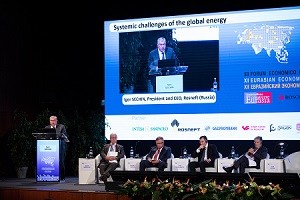
The CEO of Rosneft Oil Company Igor Sechin gave a keynote speech “Pricing the Turbulence” at the XII Eurasian Economic Forum in Verona, Italy. The main topic of the forum was “Business Connecting Eurasia from the Atlantic to the Pacific”.
Representatives of business circles, political and public figures, diplomats and experts took part in the forum. Particularly, besides the head of Rosneft, President of the Foundation for Worldwide Cooperation and ex-Prime Minister of Italy Romano Prodi, BP’s CEO Robert Dudley, CEO of Glencore Ivan Glasenberg, the Chairwoman of the Board of Eni Emma Marchegaglia, Executive Vice President for Exploration and Production of Equinor Tim Dodson, the Head of VTB bank Andrey Kostin, managing Director of German Committee on Eastern European Economic Relations Michael Harms as well as Chairman of the Board of Directors of Banca Intesa, President of the Conoscere Eurasia Association Antonio Fallico took part in the plenary session. The Head of Rosneft noted the system challenges the global energy industry faces. “A trade tariff and sanctions contention is growing in the world, the long-standing economic ties are breaking,” Igor Sechin said. He highlighted that all market players underestimate the risks of global instability.
Fundamental Factors
Igor Sechin began his speech with a review of fundamental factors which will have an impact on market developing in the nearest decades. According to him, long-term oil demand prospects are sustainable. “Although it is expected that the share of oil in the global energy mix will decrease from 34% now to 30% by 2040, its demand will increase in at least 10% taking into account the consumption volumes growth in global energy markets. By 2040, the global primary resources consumption will reach 340-400 mboed,” Sechin told.
To meet the oil demand, according to the current estimates, it is necessary to put more than 1.5 mmt of new output on commercial operation before 2030 (that is about 30 mbpd). Traditional onshore oil will be about 36% of new output, offshore oil will be 15% and the remaining 49% - hard to recover oil. According to Rosneft’s CEO, the gas demand growth will continue (by 1.1-1.8% per year).
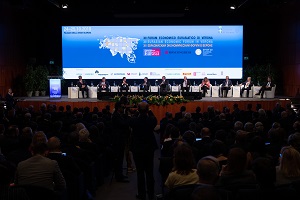 The key driver of energy resources consumption growth will become the countries of Asia-Pacific Region, Sechin noted. He said an increase in the standard of living and middle-class population will aid the mass distribution of passenger cars. It will lead to oil demand growth by 20% or 300 mmt by 2040 in Asia. More than half of this volume will fall on India, the consumption will increase significantly in China, Indonesia and Vietnam. The Head of Rosneft reminded that over the past decade alone the oil consumption in APR countries grew by a quarter and reached 1.25 bt.
The key driver of energy resources consumption growth will become the countries of Asia-Pacific Region, Sechin noted. He said an increase in the standard of living and middle-class population will aid the mass distribution of passenger cars. It will lead to oil demand growth by 20% or 300 mmt by 2040 in Asia. More than half of this volume will fall on India, the consumption will increase significantly in China, Indonesia and Vietnam. The Head of Rosneft reminded that over the past decade alone the oil consumption in APR countries grew by a quarter and reached 1.25 bt.
“In International Energy Agency long-term scenarios the share of India in global consumption of primary resources will continually increase and reach 10-11% by 2040. Already in the next years, India may become the world leader in absolute energy consumption addition, being ahead of China on this indicator. At the same time, the main part of this consuming (more than 73%) will still fall on coal and oil,” Igor Sechin told.
US Shale Oil Production
Today, a number of factors affect the global balance of supply and demand, the most important of which is the “second shale revolution” in the United States. Despite a 20% reduction in the number of active drilling rigs in the country since the beginning of the year, US shale oil production is showing steady growth due to the coordinated actions of production, infrastructure, and service companies, as well as research and development organizations. At the same time, the commercial drilling speed also increased, resulting in growth in the number of drilled wells per rig by one third. The number of drilled but incomplete wells is 7,700.
“Oil and condensate production in the United States has increased by more than 40% since the beginning of 2017 alone. The state of Texas, where the Perm Basin and other shale basins are located, is already ahead of Iran, Venezuela, and Libya in terms of oil production combined,” said Igor Sechin.
US Expanding Geography of Shipments More than 40 countries have already become buyers of US oil since the lifting of export restrictions at the end of 2015. Moreover, more than a quarter of deliveries in January-July 2019 fell on Europe, said Sechin. The expansion of US export flows is also facilitated by the active construction of pipelines and export terminals.
“At the same time, the question arises how those US investments are justified and whether the resource base is sufficient for ensuring long-term supplies? The resource base of shale oil is not yet sufficiently explored and the expected slowdown in shale production growth rates may be related particularly to downward revaluation of the shale resource potential by companies,” said Rosneft’s CEO.
The Only Market Regulator
“The increase in the share of the US oil on the global market is often achieved not so much via economic as via political methods — by ousting key players and foisting products,” Igor Sechin said, recalling that about a third of world oil reserves and fifth of global output (Iran, Venezuela, Russia) is now under American sanctions.
According to him, the United States virtually extends its jurisdiction over other countries, including the European Union, which is forced to comply with the US’ sanctions policy. At the same time, the United States itself became the main beneficiary of sanctions on the European market, increasing its oil supplies to the EU by 2.5-fold. The severance of the deal with Iran is a serious blow to the security of supplies from Middle East countries, according to Sechin. “And we are yet to assess the losses of the global energy market due to this decision,” added Rosneft’s CEO.
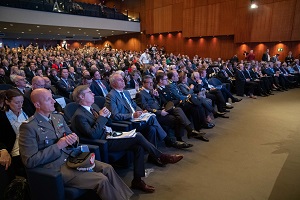 The environmental nihilism of the US administration, which refuses to take part in global green initiatives, is by no means the smallest factor in “the shale revolution”. By developing technologies, tax and financial incentives, the US is increasing shale gas production but is effectively ignoring the sharp rise in the volume of emissions from the burning of associated gas.
The environmental nihilism of the US administration, which refuses to take part in global green initiatives, is by no means the smallest factor in “the shale revolution”. By developing technologies, tax and financial incentives, the US is increasing shale gas production but is effectively ignoring the sharp rise in the volume of emissions from the burning of associated gas.
“What the US Department of Energy does not say is that appearance of the “molecules of US freedom”, i.e. additional volumes of American hydrocarbons on the market, is accompanied with an unbalanced growth of greenhouse gas emissions,” Sechin said. “A logical step to comply with the environmental commitments might be to include obligations on the associated gas utilization into the terms of supply.”
“If during the previous forums in Verona we named three “regulators” on the global oil market, Russia, Saudi Arabia and USA, now we have only one market regulator - USA, and we have to accept it,” Sechin added. In his opinion, other market players have no choice but to protect their own interests in competition, working with the existing market structure.
Recent trends demonstrate that today oil sector investments are increasingly shifting towards projects with a shorter investment cycle and a possibility to get faster return on investments. “Redistribution of investment expenditures in favour of the shale oil production will continue as long as production directly depends on oil prices, i.e. until the “shale switch” stops working,” Sechin believes.
He also noted that growth of the shale oil production has been slowing down during the recent years, and this year it may amount to 1.1 mbpd, which is 30% less than in 2018. According to a number of estimates, further production gain may fall close to zero due to a decrease in incremental capacity. “Shale oil production volumes are getting more and more difficult to control depending on the market conditions. Thus, the ability of shale oil production to be a balancing factor which allows for fast production increase in times of shortage is greatly exaggerated,” Rosneft’s CEO said.
Global Instability Factor
U.S. policy is a serious obstacle to the sustainable development of the global economy and energy, and the main reason for it is the policy of the administration of this country, which is trying to dictate its rules and conditions to other states of the world through the trade, tariff and sanctions pressure.
According to Sechin, the new rules are established by the U.S. using a wide range of tools, primarily tariff barriers and sanctions restrictions. “Americans also use a policy of threats and blackmail,” he said. “The U.S. jurisdiction expansion to other countries (arising from the extraterritoriality of sanctions) leaves these countries with the choice of either supporting sanctions or becoming the object of sanctions themselves”.
Such actions have a serious negative impact on the global economy and lead to a loss of mutual trust. “For the first time in history, the world economy faced the threat of three shock factors that could provoke a global recession: economic and technological confrontation between the United States and China, trade-tariff and currency wars, and U.S. sanctions against major oil producers,” Igor Sechin said.
Financial system imbalance
According to Sechin, the European economy is in a difficult situation. Negative rates introduced by the ECB five years ago had a significant impact on the profitability of European financial markets and the efficiency of the European banking system. And at the moment European banks are noticeably inferior to the American banks, which have profits three times as tall.
“The lack of necessary investment instruments has already led to a significant drop in the capitalization of European banks: over five years, the Euro Stoxx banking index has halved. This also has an impact on the real sector of the economy: Europeans are forced to relocate production capacities to countries with a more competitive cost component,” Rosneft CEO told.
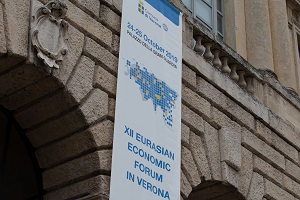 According to him, “the euro has not been able to compete fully with the dollar in twenty years of its existence. The share of the euro in the world central banks’ exchange reserves is about 20%, which is 8% lower than it was 10 years ago. At the same time, the dollar continues to dominate - its share in the world central banks’ reserves remains unchanged over the past 10 years and amounts to 62%. Therefore, with comparable sizes of the US and the EU economies, the share of the dollar in world reserves surpasses the share of the euro thrice. The share of the dollar in world trade exceeds 60%, and in trade in oil and petroleum products exceeds 90%.
According to him, “the euro has not been able to compete fully with the dollar in twenty years of its existence. The share of the euro in the world central banks’ exchange reserves is about 20%, which is 8% lower than it was 10 years ago. At the same time, the dollar continues to dominate - its share in the world central banks’ reserves remains unchanged over the past 10 years and amounts to 62%. Therefore, with comparable sizes of the US and the EU economies, the share of the dollar in world reserves surpasses the share of the euro thrice. The share of the dollar in world trade exceeds 60%, and in trade in oil and petroleum products exceeds 90%.
However, according to Sechin, historical examples show that financial monopolies can and should be resisted. So it was in 1965 when French President Charles de Gaulle challenged the dollar system of the time and exchanged cash dollars for 3,000 tons of gold, thereby devaluing the U.S. currency (which was subsequently unpegged from gold). “In 10 years’ time, we can see a very different picture, as the role of the Chinese economy grows, the share of the yuan can increase from the current 2-5% to more significant values,” Sechin said.
“Given the growing contribution of the European Union, the BRICS, and developing countries to the world economy, the future of the IMF and other international financial institutions are clearly linked to the need of finding a new balance between their participants. Perhaps the principles of their work need to be adjusted,” Igor Sechin said.
“In a situation where the United States is manipulating interest rates and abusing the position in the global economy, we must once again ask ourselves, should the dollar be the world’s reserve and trading currency? Is it possible in the current conditions to rely on the United States as a source of stability for the global economy and energy? The question is rhetorical,” the head of the Company concluded.
Green Energy and Electric Cars
Energy transformation implies meeting growing energy demands with simultaneous emission reduction and many people see the solution in the transition to the use of renewable energy production alone. Sechin noted that, since 2000, the number of countries implementing projects of renewable electricity generation increased more than twice (up to 91 countries) and capacities increased 37 times. “Against this dynamic renewable energy sources are often unreasonably idealized, while advantages of traditional energy are rejected,” the Head of Rosneft said. “The forced “greening” of energy might be costly for global economics. If we look beyond the surface, the new renewables produce energy at production cost exceeding traditional generation.”
Successful examples of alternative wind or solar energy generation present in the EU are yet unable to provide durable and continuous energy supply. In this, according to Sechin, lack of back-up by traditional generation leads to additional spending on renewable generation and the volume of this input will rise significantly with the growth of its share in the total volume of generation.
There still are questions for electric cars industry. Despite some achievements in this area, issues of decreased accumulator costs and their recycling are yet to be solved. The expansion of charging infrastructure is local and is developing in only a few countries (China, the United States and Norway, large EU agglomerations). A major role in the development of electric vehicles is played by subsidies from the authorities, the abandonment of which will call into question the future of this market. At the same time, traditional internal combustion engines are becoming increasingly efficient and oil companies are moving towards cleaner fuels, making them more attractive.
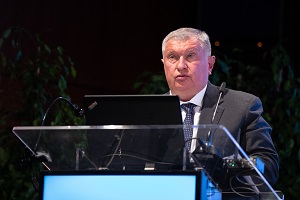 According to Sechin, a shortage of lithium, cobalt, and rare-earth metals may become one of the obstacles in the development of electric cars. The current stocks at the existing level of consumption could provide these fossil fuels for centuries to come, but the exponential growth in sales of electric vehicles projected by many analysts will lead to a similar exponential decline in the stock levels. At the same time, these metals are produced in only a few countries (the Democratic Republic of the Congo, Chile, China), which may harm the stability of the electric car industry.
According to Sechin, a shortage of lithium, cobalt, and rare-earth metals may become one of the obstacles in the development of electric cars. The current stocks at the existing level of consumption could provide these fossil fuels for centuries to come, but the exponential growth in sales of electric vehicles projected by many analysts will lead to a similar exponential decline in the stock levels. At the same time, these metals are produced in only a few countries (the Democratic Republic of the Congo, Chile, China), which may harm the stability of the electric car industry.
“The carbon footprint of electric car manufacturing exceeds that of the gasoline peers by 20-60%. After all, battery production is extremely energy intensive,” Igor Sechin noted. He said that full transition to electric cars would boost the global demand for electrical power by 30% at the very least but the renewable energy would hardly be able to meet this growth.
“In the face of rising environmental problems and the likely scarcity of metals, humanity may need to pay attention to hydrogen fuel, as hydrogen is the most common element in nature that produces pure water vapour when burned, rather than harmful emissions,” Rosneft’s CEO said.
One source of financing renewable energy is, surprisingly enough, taxation of traditional motor fuels, which makes a significant contribution to the economy and budget of the European Union. “Taxes comprise over 50% of the motor fuel price in Europe. They provided the EU budget with almost 300 bn euro, or about 2% of the region’s GDP and approximately 5% of the budget revenue. Thus, the reduction in consumption of petroleum products may have a negative impact on the economy due to the reduction of tax revenues,” Sechin believes. He also noted that replacing traditional generation with renewables in excess of the natural retirement volumes would slow down economic growth.
“Ultra-efficient solutions and technologies are required for a fundamental change in the global energy paradigm and the transition to renewable energy solely, but they are not yet available... A reasonable balance between traditional and renewable energy is vital. We should take into account economic, technological, and environmental aspects, and not seek to switch to alternative generation at any cost. This is where we see a great potential for work,” Igor Sechin said.
He noted that renewable energy along with the development of shale production and US pressure on the oil market is another factor in world energy instability. “It still needs subsidies and cannot ensure the stability of supplies. Over the next few decades, we will see the coexistence of conventional and renewable energy,” Sechin said. “We face the challenge of eliminating energy inequality, which does not mean abandoning oil and gas, but rather the balanced development of conventional and renewable energy, environmental protection and the introduction of energy-efficient technologies.”
Eurasia Energy Bridges
Russia is the largest and most reliable supplier of energy resources across Eurasia. Since 2015, the supplies of crude and oil products from Russia to EU countries have increased by 7%, to China by 60%, to India by 13 times. “For Europe, the long-term process of energy transition will be accompanied by a reduction in its own oil production, hence the challenge of ensuring uninterrupted supplies must be met... Russia has been and is the largest and most reliable supplier of energy resources to Europe and has all the market capacities to maintain this status,” Igor Sechin said.
He reminded
that Russia is the most advantageous country behind the Middle East on the cost curve, and Rosneft is the world’s leading public company in terms of unit capital and operating costs of oil production.
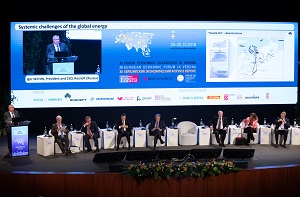 The instability of supplies from a number of countries that are the largest oil producers is aggravated by pressure from the U.S. seeking to remove reliable partners and stable suppliers from the market. The pool of such suppliers is shrinking, and their “premium” and value to consumers is increasing dramatically.
The instability of supplies from a number of countries that are the largest oil producers is aggravated by pressure from the U.S. seeking to remove reliable partners and stable suppliers from the market. The pool of such suppliers is shrinking, and their “premium” and value to consumers is increasing dramatically.
“Isolating Russia, the largest oil and gas supplier to Europe, and limiting supplies under false pretexts is a serious mistake. As we can see, the price of this mistake is extremely high. With the European economy slowing down, the rising oil price significantly reduces the prospects for recovery,” the CEO of the oil company said.
Rosneft implements joint projects with European and Asian partners, and they value the atmosphere of trust and consideration of mutual interests, says Sechin.
“Our projects contribute to the development of economies in all countries where we operate and are implemented with the utmost respect for the environment. We demonstrate in practice that the oil and gas industry can be environmentally and socially sustainable,” he said.
Vostok Oil is one of such projects the part in which Rosneft is offering to take. Igor Sechin mentioned that the Company was discussing prospects of participation in the project with peers from Asia-Pacific, Middle East, and Western countries.
By implementing its projects, Rosneft expands access to environmentally friendly energy resources and reduces greenhouse gas emissions. The Company had presented its public position on its commitment to 17 UN Sustainable Development Goals back in December 2017. Over the past five years, more than 125 bn rubles (over $2 bn) have been invested in associated gas utilization technologies. “Our efforts will help prevent eight million tonnes of greenhouse gas emissions by 2022,” Sechin explained.
As part of this work, the Company is also increasing its natural gas production, which significantly reduces greenhouse gas emissions by replacing less environmentally friendly fuels and developing environmentally friendly technologies along the entire production chain. The accumulated volume of Rosneft’s green investments has amounted to 240 bn rubles (over $4 bn) in the past five years.
Concluding his speech at the session, Igor Sechin said that “despite the difficulties, the global energy industry has great potential for further development.” “It is vital to handle the challenge of meeting the growing demand for energy while reducing emissions at the same time. Clearly, oil and gas will remain the key resources for achieving this in the long-term,” the head of Rosneft said. At the same time, the Eurasian Partnership may become a pillar of stability and a global integrator.
Igor Sechin’s speech AT XII Eurasian economic forum October 24, 2019, Verona, Italy
Rosneft
Information Division
October 24, 2019